
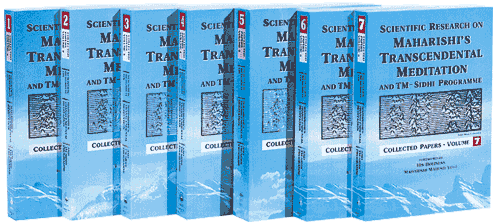
| ‘Through the window of science we see the dawn of the Age of Enlightenment.’ —Maharishi |
The following findings are a brief summary of the hundreds of scientific papers with reference to improved health, published in Scientific Research on Maharishi’s Transcendental Meditation and TM-Sidhi Programme: Collected Papers—Volumes 1–6 [over 5,000 pages; Volume 7 is in press]. More than 600 scientific studies, conducted at over 250 independent research institutions in 33 countries, objectively document the benefits of Maharishi’s Transcendental Meditation and TM-Sidhi Programme, and prove their extraordinary value to actualize the highest Vedic ideals of life, bringing fulfilment to the individual and to all areas of society. (Refer to: www.tm.org/research/508_studies.html)
These studies are a record of the historic transformation of time, from the scientific age to the Age of Enlightenment, brought about by Maharishi’s teachings, which have opened the gates of enlightenment for millions of people, leading to the establishment of an ideal quality of life for the whole world—Heaven on Earth.
A Brief Summary of Results
An analysis of findings which demonstrate the ability of
Maharishi’s Transcendental Meditation and TM-Sidhi Programme
to create holistic improvements in the physical and mental health
of the individual, as well as increased collective health in the whole society
[The numbers within parentheses after each finding
refer to the numbers of the
original research studies as printed in the six volumes of the Collected Papers.]
GROWTH OF PERFECT PHYSICAL HEALTH
Reversal of the Ageing Process
- Benefits for the Elderly Demonstrating Reversal of Ageing: Increased
Longevity; Increased Cognitive Flexibility; Increased Learning Ability; Improvements
in Self-Reported Measures of Behavioural Flexibility and Ageing; Improved
Mental Health; Reduction of Blood Pressure to More Ideal Levels; Feeling
Better and More Relaxed after Practice of the Transcendental Meditation Technique (Vol. 4: 300; Vol. 5: 380)
- Younger Biological Age Compared with Population Norms (Vol. 3: 242, 245, 246)
- Younger Biological Age Compared with Control Subjects (Vol. 3: 242)
- Lower Erythrocyte Sedimentation Rate Levels Indicating Less Serious Illness
and Slower Ageing (Vol. 5: 377)
- Duration of Practice of Maharishi’s Transcendental Meditation and
TM-Sidhi Programme Found to Be Correlated with Younger Biological Age (Vol. 3: 242, 245, 246)
- Duration of Practice of Maharishi’s Transcendental Meditation and
TM-Sidhi Programme Found to Be Predictive of:
- Younger Physiological
Age as Reflected in Levels of Systolic Blood Pressure and Auditory Threshold (Vol.
3: 245)
- Superior Performance on Tests Measuring Age-Related Psychological
Variables: Visual Memory, Creativity, Field Independence, Perceptual Speed,
Motor Speed, Reaction Time, and Non-Verbal Intelligence (Vol.
3: 257, Vol. 5: 392, 393)
- Younger Physiological
Age as Reflected in Levels of Systolic Blood Pressure and Auditory Threshold (Vol.
3: 245)
- Multiple Improvements in Factors Most Closely Associated with Longevity: Cardiovascular Health, Work Satisfaction, Positive Health Habits, Physical Function, Happiness Rating, Self-Health Rating, Intelligence, and Mental Health (Please refer to appropriate findings throughout Volumes 1, 2, 3, 4, 5, and 6.)
A Unique State of Deep Rest during Maharishi’s Transcendental Meditation
Technique—The Perfect Means to Eliminate Stress and Promote Orderliness
in Physiological Functioning
- Decreased Metabolic Rate: Decreased Oxygen Consumption (Vol. 1: 1–4, 6, 7, 9; Vol. 2: 108, 130; Vol. 3: 205; Vol. 5: 357, 359)
- Decreased Carbon Dioxide Elimination (Vol. 1: 1–4, 6, 7, 9; Vol. 2: 108; Vol. 3: 205)
- Results of Meta-Analysis: Greater Reduction in Respiration Rate during the Transcendental Meditation Technique than during Eyes-Closed Periods (Vol. 5: 356)
- Periodic Natural Breath Suspension (Vol. 1: 7, 8; Vol. 3: 197, 205, 213; Vol. 4: 293; Vol. 5: 358)
- Decreased Heart Rate (Vol. 1: 1–4, 6; Vol. 2: 108; Vol. 3: 197, 205; Vol. 4: 302; Vol. 5: 357)
- The Experience of Pure Consciousness Found to Be Associated with High EEG Coherence; Marked Reductions in Respiration Rate, Heart Rate, and Metabolic Rate; Periodic Natural Breath Suspension; Absence of Spontaneous Skin Resistance Responses; High Basal Skin Resistance (Vol. 1: 7; Vol. 3: 197, 205, 213, 218; Vol. 4: 293; Vol. 5: 358)
Improved Health of the Cardiovascular System
- Decreased Blood Pressure in Hypertensive Subjects (Vol. 1: 32–34; Vol. 2: 124, 125; Vol. 3: 233, 235, 238)
- Reduction of Blood Pressure to More Ideal Levels in Normotensive Subjects (Vol. 1: 53; Vol. 2: 124; Vol. 3: 233, 244–246; Vol. 4: 300; Vol. 5: 380)
- Lower Hospital Admissions Rate for Heart Disease (Vol. 5: 378)
- Decreased Need for Anti-Hypertensive Medications (Vol. 3: 238, 247)
- Improved Cardiovascular Efficiency (Vol. 1: 35, 53; Vol. 2: 130)
- Improved Blood Sugar Control in Patients with Diabetes Mellitus (Vol. 3: 238)
- Transcendental Meditation more effective in reducing high blood pressure compared to other stress reduction programmes (Current Hypertension Reports 9:520–528, 2007)
Improved Health of the Respiratory System
- Improvements in Patients with Bronchial Asthma:
- Decreased Severity of Symptoms (Vol. 1: 36–38;
Vol. 3: 232, 238)
- Reduced Airway Resistance (Vol.
1: 36–38)
- Decreased Need for Anti-Asthmatic Drugs (Vol.
3: 238, 247)
- Decreased Severity of Symptoms (Vol. 1: 36–38;
Vol. 3: 232, 238)
- Improvements in Patients with Chronic Bronchitis (Vol.
3: 238)
- Increased Respiratory Efficiency (Vol. 1: 6; Vol.
2: 130)
- Lower Hospital Admissions Rate for Nose, Throat, and Lung Diseases (Vol. 5: 378)
Improved Health of the Nervous System
- Increased Orderliness of Brain Functioning (Vol. 1: 1-4, 14–18, 20, 102; Vol. 2: 115, 117, 121; Vol. 3: 205, 210, 211, 213, 215, 217, 218, 224; Vol. 4: 294–296)
- Increased Integration of Brain Functioning (Vol. 1: 14–17, 20, 102; Vol. 3: 205, 210, 211, 213, 215, 217, 218, 224; Vol. 4: 294–296; Vol. 5: 370, 371, 375)
- Increased Brainwave Coherence (Vol. 1: 20, 21, 102; Vol. 3: 205, 210, 213, 215, 217, 218, 224; Vol. 4: 294, 296; Vol. 5: 370, 371)
- Increased EEG Coherence at the Moment of Performance of the TM-Sidhi Technique of Yogic Flying (Vol. 1: 102; Vol. 5: 375)
- Increased EEG Coherence during Acquisition of New Information Found in Participants of Maharishi’s Transcendental Meditation Programme (Vol. 5: 372)
- Increased Blood Flow to the Brain (Vol. 2: 105, 106; Vol. 3: 194, 195)
- Correlations Found in Subjects Practising Maharishi’s Transcendental Meditation and TM-Sidhi Programme:
- Between Duration of Practice of Transcendental Meditation and High EEG
Coherence (Vol. 4: 296)
- Among High EEG Coherence,
High Levels of Creativity, Neurological Efficiency, and Experience of Transcendental
Consciousness (Vol.
1: 21)
- Among High EEG Coherence, Experiences of Higher States of
Consciousness, Quality of Experiences of the TM-Sidhis, and High Levels
of Creativity (Vol.
1: 102; Vol. 3: 216)
- Between Increased Frontal EEG Coherence and Increased
Creativity (Vol.
4: 294)
- Between Flexibility of Concept Learning and Both High EEG Coherence
and Neurological Efficiency (Vol. 3: 219)
- Between
Neurological Efficiency and Both High EEG Coherence and Superior Academic
Performance (Vol. 3: 230, 231)
- Between High
EEG Coherence and Superior Performance in Mathematics (Vol.
3: 221)
- Between High EEG Coherence and Greater Moral Maturity, Greater
Intelligence, Superior Academic Performance, and Lower Neuroticism (Vol.
4: 294)
- Between High EEG Coherence and Both High Levels of
Principled Moral Reasoning and a Unified Cosmic Perspective on
Life (Vol.
3: 223)
- Between High EEG Coherence and More Ideal Social
Behaviour (Vol.
4: 297)
- Between High EEG Coherence and Superior Performance on Age-Related
Psychological Variables (Vol. 3: 225)
- Between Duration of Practice of Transcendental Meditation and High EEG
Coherence (Vol. 4: 296)
- Improved Left Hemispheric Functioning—Improved Verbal and Analytical Thinking (Vol. 1: 54–56, 58, 62, 63, 103; Vol. 2: 134; Vol. 3: 260, 265; Vol. 5: 387, 389, 390, 392)
- Improved Right Hemispheric Functioning—Improved Synthetic and Holistic Thinking (Vol. 1: 103; Vol. 2: 135, 140; Vol. 3: 257, 260; Vol. 5: 393)
- Increased Sensitivity, Strength, and Flexibility of the Nervous System (Vol. 4: 301)
- Increased Cognitive Flexibility, Increased Learning Ability in the Elderly (Vol. 4: 300; Vol. 5: 380)
Improved Health of the Autonomic Nervous System
- Increased Autonomic Stability (Vol.
1: 25–28, 87; Vol. 2: 123, 130; Vol. 3: 197, 205; Vol. 5: 356)
- More Effective Interaction with the Environment: Improved Resistance to Stress (Vol. 1: 25–28; Vol. 2: 123; Vol. 5. 370)
- Improved Stress Reactivity: Lower Beta-Adrenergic Receptor Sensitivity; Lower Blood Pressure Reactivity to Stress; More Normal Resting Blood Pressure; Lower Resting Epinephrine Level (Vol. 5: 367)
Improved Perceptual Ability
- Improved Auditory Thresholds (Vol. 1: 104;
Vol. 3: 245, 246, 252; Vol. 4: 301, 302)
- Improved Auditory Discrimination (Vol. 1: 50; Vol.
2: 123, 128; Vol. 3: 256)
- Greater Vigilance and Capacity for Selective Attention (Vol.
3: 251; Vol. 4: 300)
- Increased Field Independence: Growth of a Stable Internal Frame of Reference (Vol.
1: 51, 52, 103; Vol. 3: 255, 257, 259; Vol. 4: 307; Vol. 5: 384, 389)
- Greater Perceptual-Motor Speed and Non-Verbal Intelligence Correlated with Number of Months Practising the TM-Sidhi Programme (Vol. 3: 257; Vol. 5: 393)
Improved Mind-Body Coordination
- Increased Motor-Cognitive Flexibility (Vol. 1: 103)
- Improved Athletic Performance and Mind-Body Coordination: Improved Running
Speed, Agility, and Standing Broad Jump (Vol. 1: 53;
Vol. 2: 130
- Correlations Found between Experiences of Higher States of Consciousness and Superior Performance on Tests Measuring Perceptual Speed, Flexibility, Creativity, Intelligence, Field Independence, and Psychomotor Speed in Subjects Practising Maharishi’s Transcendental Meditation and TM-Sidhi Programme (Vol. 3: 258)
Beneficial Effects in Disorders of the Nervous System
- Lower Hospital Admissions Rate for Diseases of the Nervous System (Vol. 5: 378)
- Improvements in Patients with Epilepsy:
- Reduced Frequency and Severity of Seizures (Vol. 3:
202)
- Reduction of Abnormal EEG Features (Vol.
3: 202)
- Normalization of Neurotransmitter Metabolite Levels
(Vol. 3: 202)
- Reduced Frequency and Severity of Seizures (Vol. 3:
202)
- Decreased Stuttering (Vol. 1: 43; Vol. 4: 298)
Improved Health of the Endocrine System
- Increased Endrocrinological Efficiency: Lower Baseline Levels of Pituitary Hormones (TSH, Growth Hormone, and Prolactin), with Maintenance of Levels of Adrenal and Thyroid Hormones and Insulin, in Long-Term Practitioners of Maharishi’s Transcendental Meditation Technique (Vol. 5: 363, 364)
- Increased Plasma Level of Arginine Vasopressin, Associated with Body Fluid Balance and with Learning and Memory (Vol. 5: 366)
- Improved Glucose Tolerance (Vol. 3: 240; Vol. 4: 299)
Improved Health of the Immune System—
Increased Resistance to Disease
- Fewer Infections (Vol. 1: 2; Vol. 3: 238, 239)
- Reduced Inflammation of the Gums (Vol. 1: 39; Vol. 3: 237)
- Decreased Need for Antihistamines (Vol. 3: 247)
- Unique Pattern of DNA Repair (Vol. 5: 360)
Improved Health of the Musculoskeletal System
- Lower Hospital Admissions Rate for Bone and Muscle Diseases (Vol. 5: 378)
- Improvements in Patients with Chronic Back Pain, Rheumatoid Arthritis, and Other Complaints (Vol. 3: 238)
- General Improvements (Vol. 3: 241)
Improved Health of the Digestive System
- Lower Hospital Admissions Rate for Gastrointestinal Disorders and Irregularities of Metabolism (Vol. 5: 378)
- Improved Periodontal Health (Vol. 1: 39; Vol. 3: 237)
- Improvements in Patients with Dyspepsia, Chronic Colitis, and Other Complaints (Vol. 3: 238)
Better Health for Mother and Child
before and after Childbirth
- Less Anxiety during Pregnancy and Childbirth (Vol.
3: 234)
- Shorter Stay in the Hospital for Child Delivery (Vol.
5: 378)
- Greater Frequency and Longer Duration of Breast-Feeding (Vol.
3: 234)
- Greater Quiet Alertness in Newborns of Mothers Practising Maharishi’s Transcendental Meditation and TM-Sidhi Programme (Vol. 5: 381)
Improved Health Habit
- Decreased Use of Cigarettes (Vol. 1: 80, 84; Vol. 2: 150, 153, 161–163; Vol. 3: 239, 247, 276, 280, 287; Vol. 5: 399)
- Decreased Use of Alcohol (Vol. 1: 73, 80, 83–85, 95; Vol. 2: 126, 150, 153, 162, 163; Vol. 3: 239, 247, 282, 287; Vol. 4: 313; Vol. 5: 399)
- Decreased Drug Abuse (Vol. 1: 73, 79–82, 84–86, 89, 90, 95; Vol. 2: 153, 161–163; Vol. 3: 239, 247, 277, 282, 287)
- Decreased Intake of Caffeine (Vol. 2: 163; Vol. 3: 239)
- Increased Cooperation with Medical Advice (Vol. 3: 238)
Improved General Health
- Lower Health Insurance Utilization Rates: Significantly Fewer Hospital In-Patient Days; Fewer Outpatient Visits in All Age Categories; Fewer In-Patient Admissions for All Major Categories of Disease (Vol. 5: 378)
- Lower Health Insurance Utilization Rates among University Faculty and Staff Practising Maharishi’s Transcendental Meditation and TM-Sidhi Programme (Vol. 5: 379)
- Unique Pattern of DNA Repair (Vol. 5: 360)
- Maintenance of a Relaxed Style of Physiological Functioning outside of the Practice of Maharishi’s Transcendental Meditation Technique (Vol. 1: 6, 18, 30; Vol. 3: 197; Vol. 5: 356, 358, 359)
- Decreased Fatigue (Vol. 2: 147; Vol. 3: 238; Vol. 4: 308; Vol. 5: 399)
- Improved Self-Health Rating (Vol. 1: 2; Vol. 3: 239, 247; Vol. 4: 300, 304; Vol. 5: 399)
- Decreased Susceptibility to, and Discomfort from, Physical and General Complaints (Vol. 3: 241)
- Improved Mental and Physical Health in Patients on a Kidney Transplant/Dialysis Programme (Vol. 2: 125)
- Fewer Accidents (Vol. 3: 239)
- Improvements in Patients with Chronic Headaches (Vol. 1: 2, 95; Vol. 3: 238, 243)
- Normalization of Body Weight:
- More Successful Weight Reduction in Obese Subjects (Vol.
3: 238, 290)
- Changes towards Ideal Body Weight in Both Overweight
and Underweight Subjects (Vol.
1: 44; Vol. 3: 238)
- Improved Psychological Health in Subjects Undertaking
Dietary Treatment for Obesity (Vol. 3: 290)
- More Successful Weight Reduction in Obese Subjects (Vol.
3: 238, 290)
- Improvements in Physical Health Positively Correlated with Duration and Regularity of Practice of Maharishi’s Transcendental Meditation Technique (Vol. 3: 247)
- Greater Family Health (Vol. 5: 400)
GROWTH OF PERFECT MENTAL HEALTH
- Lower Health Insurance Utilization for All Mental Disorders (Vol.
5: 378)
- Improvements in Mental Health Positively Correlated with Duration and Regularity
of the Practice of Maharishi’s Transcendental Meditation Technique (Vol.
3: 247)
- Prevention of Psychiatric Illness (Vol. 2: 127)
- Orientation toward Positive Values (Vol. 5: 394)
Increased Integration of Personality
and Growth of Higher States of Consciousness
- Experience of Pure Consciousness during the Practice of Maharishi’s Transcendental Meditation Technique (Vol. 1: 2, 7, 8, 21, 99–102; Vol. 3: 197, 205, 213, 216, 218, 258)
- More Frequent Experiences of Higher States of Consciousness (Vol. 5: 397)
- Increased Self-Actualization: Increased Integration, Unity, and Wholeness of Personality (Vol. 1: 64, 67, 69, 70, 72, 74, 76, 78, 94; Vol. 2: 139, 144, 151, 153, 155; Vol. 3: 239; Vol. 5: 395)
- Greater Ability to Bring the Inner Self to Healthy Expression (Vol. 2: 141)
- Greater Orientation toward Positive Values: Better Recall for Positive Words than for Negative Words; Lower Recognition Thresholds for Positive Words than for Negative Words; More Positive Appraisal of Others (Vol. 5: 394)
- Greater Commitment to Personal Development (Vol. 2: 138)
- Increased Inner-Directedness: Greater Independence and Self-Supportiveness (Vol. 1: 64, 69, 70, 72, 76, 94; Vol. 2: 139, 151, 153, 155; Vol. 3: 268)
- Increased Autonomy and Independence (Vol. 1: 62, 71; Vol. 2: 151, 153; Vol. 5: 395)
- Less Sensitivity to Criticism (Vol. 1: 67)
- Less Tendency to Worry about Other People’s Opinions (Vol. 2: 164)
- Less Need to Belong and Be Accepted (Vol. 3: 268)
- Increased Self-Discipline (Vol. 4: 316)
- Enhanced Self-Concept (Vol. 2: 142, 144, 148, 156; Vol. 3: 274; Vol. 5: 371)
- Enhanced Self-Regard and Self-Esteem (Vol. 1: 62, 64, 67, 69, 76, 90; Vol. 2: 139, 151, 153, 156, 158; Vol. 3: 239, 266, Vol. 5: 371)
- Increased Self-Confidence and Self-Assuredness (Vol. 1: 65, 77; Vol. 2: 150, 164; Vol. 3: 261, 277, 290; Vol. 4: 308)
- Enhanced Inner Well-Being (Vol. 2: 125, 147; Vol. 4: 310; Vol. 5: 395)
- Increased Inner Calm and Tranquillity (Vol. 1: 65, 73, 77; Vol. 2: 150; Vol. 4: 308, 316)
- Increased Happiness (Vol. 1: 90; Vol. 2: 147, 165; Vol. 4: 308)
- More Balanced Mood (Vol. 1: 65, 77; Vol. 3: 277; Vol. 4: 308)
- Increased Naturalness (Vol. 1: 65, 77; Vol. 3: 277, 290; Vol. 4: 308)
- Increased Moral Maturity (Vol. 1: 91; Vol. 3: 265, 270; Vol. 4: 309)
- Increased Altruism (Vol. 1: 71; Vol. 2: 138)
- Increased Intrinsic Spirituality (Vol. 5: 395)
- Greater Respect for Traditional Religious Values (Vol. 2: 138)
- Greater Satisfaction with One’s Moral Worth and with One’s Relationship to God and Religion (Vol. 2: 156)
- High Level of Moral Atmosphere (Vol. 4: 309)
- Increased Ability to See the Opposites of Life as Meaningfully Related (Vol. 1: 76)
- Increased Ability to Connect Past, Present, and Future Meaningfully (Vol. 1: 69, 70, 76, 94; Vol. 2: 151, 153, 155)
- Decreased Tendency to Procrastinate (Vol. 1: 65, 77; Vol. 3: 277)
- Increased Practicality and Realism (Vol. 2: 153)
- Decreased Number of Situations in Life Perceived as Problems (Vol. 2: 142)
- Decreased Number of Serious Problems Experienced (Vol. 2: 142)
Increased Intelligence, Learning Ability,
and Intellectual Performance
- Increased Intelligence (Vol. 1: 53–55, 62, 103; Vol. 2: 150; Vol. 3: 257, 261, 265; Vol. 4: 307; Vol. 5: 382, 387, 389, 390, 392, 393)
- Improved Spontaneous Organization of Memory (Vol. 1: 58; Vol. 2: 134, 136)
- Increased Field Independence, Indicating Broader Comprehension and Increased Ability to Focus Attention (Vol. 1: 51, 52, 103; Vol. 3: 255, 257, 259; Vol. 4: 307; Vol. 5: 384, 389)
- Increased Mental Clarity and Wakefulness (Vol. 2: 147)
- Improved Problem-Solving Ability (Vol. 1: 58, 62)
- Improved Ability to Deal with the Abstract and Complex (Vol. 1: 62)
- Improved Standardized Test Scores on General Academic Achievement, Social Studies, Literary Materials, Reading, Mathematics, Language, and Work/Study Skills (Vol. 5: 385, 386)
Increased Creativity
- Enhanced Creativity (Vol. 1: 62, 63, 103; Vol. 2: 150; Vol. 3: 257, 260; Vol. 4: 294, 304, 305; Vol. 5: 392, 395)
- Increased Resourcefulness (Vol. 2: 150, 153)
- Increased Innovation (Vol. 1: 62)
Increased Energy and Vitality
- Increased Readiness for Activity (Vol. 2: 147)
- Increased Alertness (Vol. 1: 29; Vol. 2: 164; Vol. 5: 381)
- Increased Energy and Endurance (Vol. 1: 62; Vol. 2: 130)
- Growth of a More Brave, Adventurous, Action-Oriented Nature (Vol. 1: 73)
- Greater Physical Well-Being (Vol. 4: 308)
Reduction in Negative Personality Characteristics
- Decreased Anxiety (Vol. 1: 33, 35, 61, 62, 68, 71, 72, 74, 75, 78, 81, 84, 88–90, 92, 93, 95; Vol. 2: 125, 133, 138, 143, 145, 148, 150, 153, 154, 157, 160; Vol. 3: 234, 238, 243, 268, 273, 275, 278, 280, 281, 284, 288, 290; Vol. 4: 308, 310, 311, 313, 314, 316; Vol. 5: 370, 399)
- Decreased Tension (Vol. 1: 65, 77, 81; Vol. 2: 157, 161; Vol. 3: 277, 281, 284, 290; Vol. 4: 308; Vol. 5: 399)
- Decreased Hidden Mental Turbulence (Vol. 3: 269)
- Decreased Frustration (Vol. 2: 150, 153)
- Decreased Irritability (Vol. 1: 65, 73, 77; Vol. 2: 147, 158, 164; Vol. 3: 278; Vol. 4: 308)
- Decreased General Maladjustment; Decreased Personality Disorder (Vol. 5: 371)
- Decreased Hostility (Vol. 2: 142, 143, 158, 160; Vol. 3: 278, 280; Vol. 4: 314)
- Decreased Need for Tranquillizers (Vol. 2: 150, 163; Vol. 3: 238, 239, 243, 247, 267)
- Decreased Need for Antidepressants (Vol. 3: 247)
- Orientation toward Positive Values: Better Recall for Positive than for Negative Words; Lower Recognition Thresholds for Positive Words than for Negative Words; More Positive Appraisal of Others (Vol. 5: 394)
Benefits in Psychiatry
- Prevention of Psychiatric Illness (Vol. 2: 127)
- Improvements in Anxiety Neurosis (Vol. 1: 95; Vol. 2: 157; Vol. 3: 238)
- Improvements in Obsessive-Compulsive Neurosis (Vol. 1: 95)
- Improvements in Psychosomatic Disorders (Vol. 1: 95; Vol. 3: 232)
- Improvements in Schizophrenia (Vol. 2: 157; Vol. 3: 281, 283)
- Improvements in Manic-Depressive Psychosis (Vol. 3: 281)
- Improvements in Addictive Disorders, Including Alcoholism and Drug Abuse (Vol. 1: 95; Vol. 2: 157; Vol. 3: 283)
- More Effective Rehabilitation of Patients following Discharge from a Vocational Rehabilitation Unit:
- Greater Ability to Maintain Employment (Vol. 3: 283)
- More
Often Maintained on Out-Patient Care Alone (Vol. 3:
283)
- Greater Ability to Maintain Employment (Vol. 3: 283)
- Improvements in Aggressive Psychiatric Patients:
- Decreased Frequency and Severity of Attacks of Aggressive Behaviour (Vol.
3: 202)
- Normalization of Neurotransmitter Metabolite and Plasma
Cortisol Levels (Vol.
3: 202)
- Improvements in Autism: Decreased Echolalic Behaviour (Vol. 3: 262)
- Decreased Frequency and Severity of Attacks of Aggressive Behaviour (Vol.
3: 202)
Benefits in Special Education
- Increased Self-Actualization with Regard to Aspects of Personality Relevant to Learning Disorders in Economically Deprived Adolescents with Learning Problems: Increased Independence and Self-Supportiveness, and Improved Self-Regard (Vol. 2: 139)
- Decreased Dropout Rate from School in Economically Deprived Adolescents with Learning Problems (Vol. 2: 139)
- Benefits for Children with Learning Problems: Decreases in Anxiety, Examination Anxiety, and School Dislike (Vol. 2: 133)
- Decreased Stuttering (Vol. 1: 43; Vol. 4: 298)
- Decreased Overactive or Impulsive Behaviour (Vol. 2: 157)
- Improvements in Autism: Decreased Echolalic Behaviour (Vol. 3: 262)
Growth of Ideal Social Behaviour
- Increased Ability to See Man as Essentially Good (Vol. 1: 76; Vol. 2: 153; Vol. 3: 266)
- Increased Social Maturity (Vol. 2: 138; Vol. 3: 261)
- Greater Sense of Social Responsibility (Vol. 2: 138, 158)
- Increased Capacity for Warm Interpersonal Relationships (Vol. 1: 69, 70, 73, 76, 77; Vol. 2: 149, 151, 153; Vol. 3: 277, 284, 290; Vol. 4: 316)
- Increased Friendliness (Vol. 1: 65, 73, 77; Vol. 3: 277, 290)
- Greater Respect for the Views of Others (Vol. 2: 164)
- Improved Ability to Appreciate Others (Vol. 3: 271)
- Growth of a More Sympathetic, Helpful, and Caring Nature (Vol. 1: 73; Vol. 2: 153; Vol. 4: 316)
- Growth of a More Tactful, Forgiving, and Agreeable Nature (Vol. 1: 73; Vol. 2: 153)
- Greater Tolerance of Authority (Vol. 2: 138)
- Effective Rehabilitation (Vol. 1: 87–90; Vol. 2: 158, 160, 161; Vol. 3: 278–280, 284–286, 288; Vol. 4: 314, 352, 353; Vol. 5: 398, 420)
Greater Satisfaction with Marriage
- Greater Adjustment (Vol. 2: 165; Vol. 4: 315)
- Greater Happiness (Vol. 2: 165)
- Greater Harmony (Vol. 2: 165)
GROWTH OF PERFECT COLLECTIVE HEALTH
Improved Health of Society through the Maharishi Effect
The following research findings demonstrate that one per cent of a population practising Maharishi’s Transcendental Meditation Technique or the square root of one per cent collectively practising Maharishi’s TM-Sidhi Programme radiates a powerful influence of coherence and harmony in collective consciousness, bringing life in accordance with all the Laws of Natur neutralizing negative tendencies, and promoting positive trends in society as a whole.
- Decreased Incidence of Infectious Diseases (Vol. 4: 337, USA and Australia, 1983–1984)
- Improved Quality of National Life as Measured by an Index Including Rate of Infectious Diseases, Infant Mortality Rate, Suicide Rate, Cigarette Consumption Rate, Alcohol Consumption Rate, Divorce Rate, Traffic Fatality Rate, Crime Rate, Percentage of Civil Cases Reaching Trial, Gross National Product per Capita, Patent Application Rate, and Degrees Conferred per Capita (Vol. 4: 332, USA, 1976–1983)
- Improved Quality of National Life as Measured by a Weekly Index of Motor Vehicle Fatalities, Homicides, and Suicides (Vol. 5: 407, USA, 1979–1985; 408, Canada, 1983–1985)
- Improved Quality of National Life as Measured by Improvements on a Monthly Index Including Violent Fatalities (Motor Vehicle Fatalities, Homicides, and Suicides), Cigarette Consumption, and Worker-Days Lost in Strikes (Vol. 5: 408, Canada, 1972–1986)
- Improved Quality of National Life as Measured by an Index Comprising Data on Crime, the National Stock Market, and National Mood (Vol. 4: 333, Israel, 1983)
- Decreased Motor Vehicle Accidents and Fatalities (Vol. 4: 317, Cities, USA, 1973–1977; 323, USA, 1979; 325, Holland, 1979; 327, USA, 1982; 333, Jerusalem, Israel, 1983; 337, USA; South Africa; and States of New South Wales, Victoria, and Western Australia, Australia, 1983–1984)
- Decreased Air Traffic Fatalities and Air Transport Fatal Accidents (Vol. 4: 323, USA, 1979; 337, Worldwide, 1983–1984)
- Decreased Crime (Vol. 1: 98, Cities, USA, 1973; Vol. 2: 166, Cities, USA, 1974–1976; Vol. 4: 318, Cities, USA, 1973–1977; Vol. 4: 319, Cities, USA, 1975–1976; Vol. 4: 320 and Vol. 5: 402, Cities, USA, 1972–1978, and Metropolitan Areas, USA, 1973–1979; Vol. 4: 323, USA, 1979; Vol. 4: 325, Holland, 1979 and 1981; Vol. 4: 326 and Vol. 5: 401, Union Territory of Delhi, India, 1980–1981; Vol. 4: 328 and Vol. 5: 402, Washington, DC, USA, 1981–1983; Vol. 4: 333, Jerusalem and also Israel, 1983; Vol. 4: 334 and Vol. 5: 401, Puerto Rico, 1984; Vol. 4: 337, State of Victoria, Australia; Washington, DC, USA; and Karachi, Pakistan, 1983–1984; Vol. 5: 401, Metro Manila, Philippines, 1984–1985)
- Increased Progress towards Peaceful Resolution of Conflict (Vol. 4: 322, Major Trouble-Spot Countries, 1978; 335, Lebanon, 1983–1984; 337, Worldwide, 1983–1984; Vol. 5: 410, Lebanon, 1983–1985; 411, Worldwide, 1983–1985)
- Improvement in Domestic Affairs and International Relations for Major Trouble-Spot Countries (Vol. 4: 322, 1978)
- Increased Harmony in International Affairs (Vol. 4: 322, Worldwide, 1978; 337, Worldwide, 1983–1984; Vol. 5: 409, USA–USSR, 1985–1987; 411, Worldwide, 1983–1985)
- Improved International Relations: Reduced Conflict Globally, Reduced Terrorism, and Increase in World Index of Stock Prices during Three Large Assemblies of Participants in Maharishi’s Transcendental Meditation and TM-Sidhi Programme (Vol. 5: 411, Worldwide, 1983–1985)

| Decreased Blood Pressure Among Hypertensives This meta-analysis located in the published literature 107 studies on stress reduction and blood pressure, of which 17 studies containing 23 treatment comparisons among 960 subjects met standard criteria for well-designed randomized control trials in which there were multiple studies for each treatment category for hypertensive patients. Among these studies, only the Transcendental Meditation Programme was found to have a statistically significant impact of reducing high blood pressure among hypertensive subjects. Reference: Current Hypertension Reports 9: 520–528, 2007. |
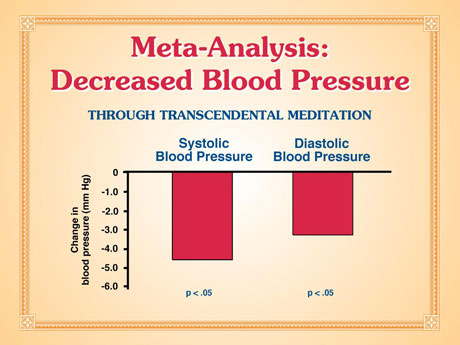
| Meta-Analysis: Decreased Blood Pressure This study was a meta-analysis examining the effect of all published randomized, controlled clinical trials on the effects of the Transcendental Meditation program on blood pressure, comprising nine studies with 711 subjects. The Transcendental Meditation Programme was found to have a statistically significant impact of reducing both systolic and diastolic blood pressure. Reference: American Journal of Hypertension 21: 310–316, 2008. |

| Those who had been regularly practising the Transcendental Meditation Programme showed younger biological age, with a greater reduction in biological age the longer they had been practising the technique. Reference: International Journal of Neuroscience 16: 53–58, 1982. |
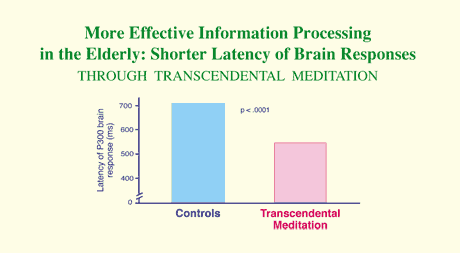
| Elderly individuals who practise Maharishi’s Transcendental Meditation Programme, in comparison to controls of the same age, show faster response of the brain to visual stimuli (shorter latency of P300 response). This type of response of the brain usually becomes slower with age, and this finding thus indicates one aspect of the reversal of the ageing process through the Transcendental Meditation Programme. Reference: Psychophysiology 26: S29 (abstract), 1989. |
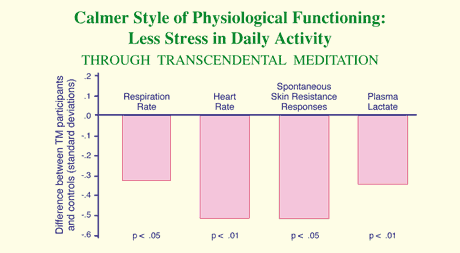
| A meta-analysis found that those who practise Maharishi’s Transcendental Meditation Programme, in contrast to controls, show outside of meditation a calmer style of physiological functioning, as indicated by lower levels of respiration rate, heart rate, spontaneous skin resistance responses, and plasma lactate. Reference: American Psychologist 42: 879–881, 1987. |
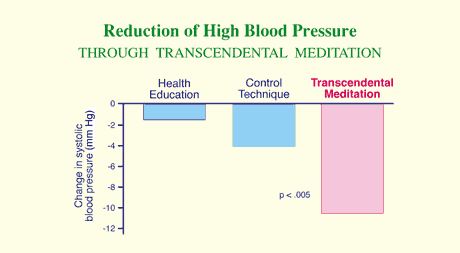
| Patients with high blood pressure who learnt the Transcendental Meditation Programme showed a significant reduction of systolic and diastolic blood pressure after three months, in contrast to those randomly assigned to a control technique or to those who received education on how to reduce blood pressure through diet and exercise. Reference: Hypertension 26: 820–827, 1995. |
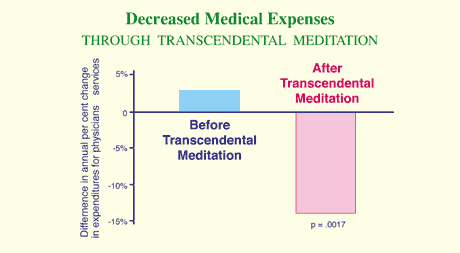
| The term ‘cardiac syndrome X’ is applied to patients with anginal chest pain and normal coronary angiograms. The twice-daily practice of the Transcendental Meditation Programme significantly reduced incidence of angina episodes, improved exercise tolerance, and increased subjective quality of life in patients suffering from this syndrome. Reference: The American Journal of Cardiology 85: 653–655, 2000. |
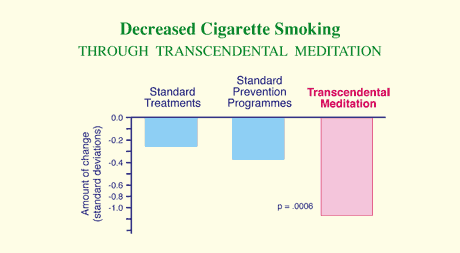
| A meta-analysis of all research studies on the Transcendental Meditation Programme related to cigarette smoking, in comparison to meta-analyses of standard treatment and prevention programmes for smoking, found a significantly greater reduction of cigarette use among those who learn the Transcendental Meditation Programme, even though this programme does not involve any guidance about change in lifestyle or habits. Reference: Alcoholism Treatment Quarterly 11: 13–87, 1994. |
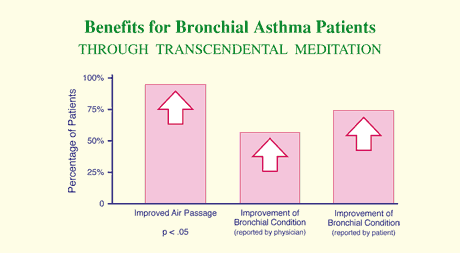
| Asthmatic patients who were instructed in the Transcendental Meditation Programme showed significant improvement after three months, as indicated by physiological measurement of lower airway resistance, and by their own personal reports and those of their physicians. Reference: Clinical Research 21: 278 (abstract), 1973. |
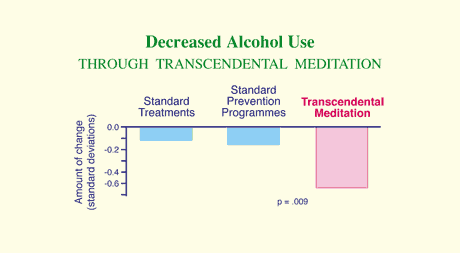
| A meta-analysis of all research studies on the Transcendental Meditation Programme related to alcohol use, in comparison to meta-analyses of standard alcohol treatment and prevention programmes, found a significantly greater reduction of alcohol use among those who learn the Transcendental Meditation Programme, even though this programme does not involve any guidance about change in lifestyle or habits. Reference: Alcoholism Treatment Quarterly 11: 13–87, 1994. |

| Those practising the Transcendental Meditation Programme reported significantly reduced use of prescribed drugs (tranquillizers, sleeping pills, antidepressants, and analgesics) since learning the Transcendental Meditation Programme, compared to matched controls. Reference: The International Journal of the Addictions 12: 729–754, 1977. |

| Those practising the Transcendental Meditation Programme reported significantly reduced use of prescribed drugs (tranquillizers, sleeping pills, antidepressants, and analgesics) since learning the Transcendental Meditation Programme, compared to matched controls. Reference: The International Journal of the Addictions 12: 729–754, 1977. |

| Subjects with high cholesterol practising the Transcendental Meditation Programme showed a significant reduction in cholesterol levels when compared to a control group. There were no changes in diet. Reference: Journal of Human Stress 5: 24–27, 1979. |
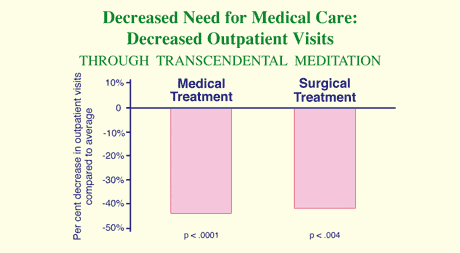
| Medical insurance data on participants in the Transcendental Meditation Programme indicated that they required significantly less outpatient doctor visits for both medical and surgical procedures in contrast to the average of all other insured persons. Reference: Psychosomatic Medicine 49: 493–507, 1987. |
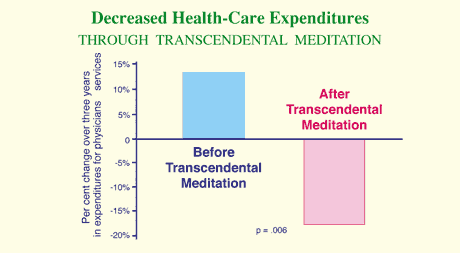
| A study of 677 people in Quebec, Canada, who learnt the Transcendental Meditation Programme found that after learning the programme government payments for physicians’ services declined significantly, in comparison to a previously increasing trend. Reference: American Journal of Health Promotion 10: 208–216, 1996. |
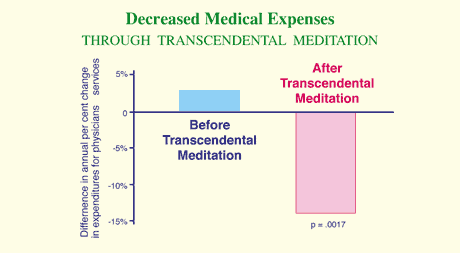
| This 14-year Canadian study of annual percentage change in inflation-adjusted government payments for physicians’ services found that 1,418 people who learnt the Transcendental Meditation Programme showed a significant annual decline of 13.8 per cent, relative to matched controls, after learning the practice. Reference: American Journal of Health Promotion 14: 284–291, 2000. |
In Conclusion
Maharishi spoke the following words over forty years ago. The truth of these words is reflected for all times in the vast body of scientific research conducted on Maharishi’s Vedic Science and Technology since then:
‘Generation after generation man is born anew. Each generation gives rise to new aspirations in life and brings a new quest for fulfilment. Each man needs sound physical and mental health, greater ability in action, a greater capacity to think clearly, increased efficiency in work, and more loving and rewarding relationships with others. He needs enough vitality and intelligence to satisfy the desires of his mind and bring contentment to his life. We have seen that all this can be gained through the regular practice of Transcendental Meditation.
‘… A new humanity will be born, fuller in conception and richer in experience and accomplishments in all fields. Joy of life will belong to every man, love will dominate human society, truth and virtue will reign in the world, peace on earth will be permanent, and all will live in fulfilment in fullness of life in God Consciousness.’
Science of Being and Art of Living—Transcendental Meditation
[374-page publication]
Links to related websites:
PTSD Relief: www.ptsdreliefnow.org/the-research.html
International Maharishi AyurVeda Foundation (IMAVF): www.imavf.org
Maharishi Light Therapy with Gems: www.gem-light-therapy.com
Maharishi AyurVeda Products International (MAPI): www.mapi.com
Maharishi AyurVeda Europe: www.ayurveda.nl
The Brain Research Institute: http://brainresearchinstitute.org
Research Results: The effect of Transcendental Meditation on self-efficacy, perceived stress, and quality of life in mothers in Uganda, 2018
Cardiovascular: Modelling the Impact of Transcendental Meditation in Stroke Incidence and Mortality, 2018
Also visit: www.TruthAboutTM.com